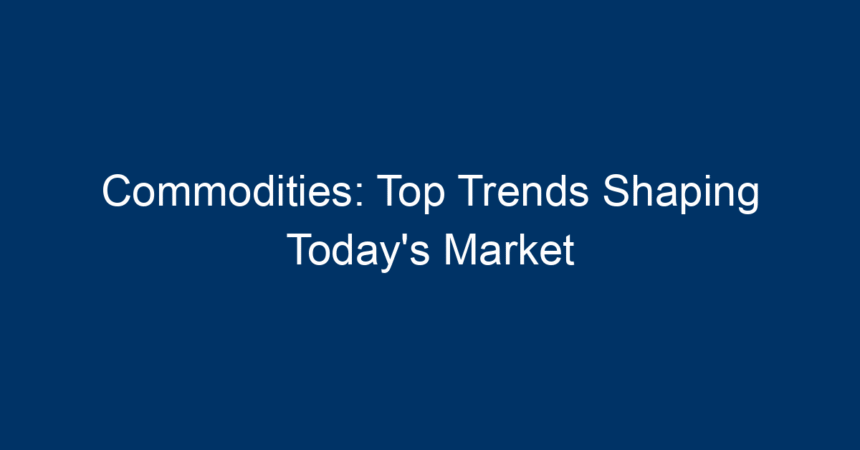In today’s dynamic financial landscape, commodities play a pivotal role in global economies. These essential raw materials, ranging from oil and gold to agricultural products, are fundamental to industry and trade. Understanding the top trends shaping the commodities market can provide investors, traders, and businesses with valuable insights into navigating this complex sector. In this article, we’ll explore the key trends affecting commodities today, the implications for various stakeholders, and actionable strategies to consider.
Understanding the Commodities Market
Commodities are broadly categorized into two types: hard commodities and soft commodities. Hard commodities typically include natural resources that are mined or extracted, such as oil, gold, and metals. Soft commodities, on the other hand, encompass agricultural products like wheat, coffee, and cotton.
The commodities market is influenced by a multitude of factors including supply and demand dynamics, geopolitical events, currency fluctuations, and technological advancements. As we delve into today’s top trends, we’ll see how these elements intertwine to shape the future of commodities.
1. Economic Recovery Post-Pandemic
Overview of Recovery Trends
As economies worldwide rebound from pandemic-induced disruptions, demand for various commodities is on the rise. Industries like construction, manufacturing, and travel are experiencing renewed activity, spurring demand for hard commodities like steel, copper, and oil. In the agricultural sector, a resurgence in consumer spending is boosting demand for food products, emphasizing the importance of soft commodities.
Implications for Investors
Investors should keep a close eye on economic indicators, such as GDP growth rates and employment statistics, which can signal shifts in demand. Additionally, sectors poised for growth, such as green energy and technology, may influence specific commodities like lithium and cobalt—key elements in battery production.
2. Geopolitical Tensions and Supply Chain Disruptions
Impact on Global Supply Chains
Geopolitical tensions, including trade disputes and conflicts, continue to impact the supply chain of various commodities. For instance, the ongoing situation in Eastern Europe has led to volatility in energy markets, with countries seeking alternative sources of oil and gas. Similarly, trade relations between major economies often lead to fluctuations in agricultural commodity prices.
Strategic Considerations for Businesses
Businesses reliant on import/export of commodities must remain agile and adaptable. Diversifying supply sources and maintaining strategic reserves can mitigate risks associated with supply chain disruptions. Traders should also consider incorporating geopolitical analysis into their investment strategies to anticipate potential shifts in commodity prices.
3. The Rise of Sustainable and Green Commodities
Growing Demand for Sustainability
Sustainability is no longer just a trend; it’s a movement that’s reshaping the commodities market. With increased awareness of climate change and resource depletion, there is a growing demand for sustainable commodities. This shift is particularly evident in the energy sector, where renewable energy sources like solar and wind power are gaining traction.
Opportunities in Green Commodities
Investors looking for future growth opportunities should consider green commodities such as hydropower, biomass, and even electric vehicle (EV) battery components. Additionally, agricultural practices are increasingly focusing on environmental sustainability, affecting commodities like organic cotton and soybeans.
4. Technological Innovations
Advancements Driving Efficiency
The commodities market is witnessing rapid technological advancements that enhance efficiency and transparency. From blockchain for supply chain tracking to AI for market forecasting, these technologies are transforming how commodities are bought and sold.
Embracing Technology
Businesses involved in commodities should stay updated on technological innovations. Implementing advanced data analytics can help predict market trends, optimize inventory management, and enhance decision-making processes.
5. Inflation and Commodity Prices
The Role of Inflation
Inflation is a critical factor shaping the commodities market. As governments worldwide stimulate their economies, concerns about inflation are on the rise. Higher inflation typically leads to increased commodity prices, as raw materials become more costly and consumers are willing to pay more for essential goods.
Making Informed Decisions
Investors and businesses must explore hedging strategies against inflation. This can include investing in tangible assets, such as gold, which has historically served as a hedge during inflationary periods. Keeping abreast of economic policies from central banks is also essential for anticipating market shifts.
6. Global Climate Policies and Regulations
Regulations Impacting Commodity Production
As governments become more proactive in addressing climate change, regulations regarding commodity production are tightening. Emission controls, sustainability standards, and carbon trading systems are being implemented, influencing how commodities are sourced and produced.
Adapting to New Regulations
Businesses in the commodities sector should proactively adapt to these regulations by investing in sustainable practices. Engaging in sustainable sourcing and reducing carbon footprints can improve compliance while also appealing to environmentally-conscious consumers.
Conclusion: Actionable Insights for Stakeholders
Understanding the trends shaping today’s commodities market is essential for making informed investment and business decisions. Here are some actionable insights for stakeholders:
-
Monitor Economic Indicators: Stay updated on economic signals that could impact demand for hard and soft commodities.
-
Diversify Supply Chains: Reduce risks by sourcing commodities from multiple suppliers and regions.
-
Invest in Green Commodities: Consider the long-term potential of sustainable commodities, especially as global policies shift toward sustainability.
-
Leverage Technology: Implement modern technologies to optimize operations, improve efficiency, and harness data for strategic insights.
-
Hedge Against Inflation: Explore investment options that traditionally serve as hedges during inflationary periods, such as precious metals.
- Stay Informed on Regulations: Stay abreast of climate policies and adapt business practices accordingly to meet regulatory requirements.
By staying informed and adaptable, investors and businesses can navigate the evolving landscape of the commodities market and leverage opportunities for sustainable growth in this crucial sector.
This comprehensive analysis provides a keen understanding of the key trends shaping today’s commodities market while offering actionable insights for stakeholders engaged in this vital industry. Whether you’re a seasoned investor or a business owner, recognizing these trends will enhance your strategic positioning in the global market.



